Using third party software with Koha
MarcEdit
Many libraries like to use MarcEdit for modifications or data cleanup. If you'd like to do this you will need to download it at: http://marcedit.reeset.net/
Important
Many of the actions described in this chapter can be done in Koha using Marc Modification Templates, but this section is here for those who are used to MarcEdit.
إضافة بادئة لأرقام الاستدعاء
عندما يتم جلب البيانات إلى نظام كوها، ربما قد تريد تنظيفة أولاً. عمل مشترك واحد بين مستخدمي نظام كوها هو إضافة بادئة إلى رقم الاستدعاء.
افتح MarcEdit
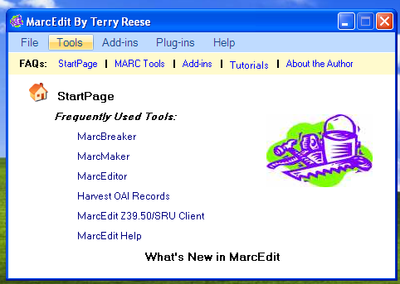
انقر على 'MarcEditor'
Go to Tools > Edit Subfield Data

To prepend data the special character is: ^b To simply prepend data to the beginning of a subfield, add ^b to the Field Data: textbox and the data to be appended in the Replace

To prepend data to the beginning of the subfield while replacing a text string, add ^b[string to replace] to the Field Data textbox and the data to be appended in the Replace With textbox.
إستيراد بيانات الأكسل إلى نظام كوها
Suppose you have records of your library in excel data sheet format and want them to import into Koha. But how will you do this? Koha will not let you import excel records directly. Well here is a very simple solution for you which will let you import your excel records in Koha easily. First, we will convert excel file into Marc file and then will import it into Koha.
إتبع الخطوات الواردة في إستيراد سجلات الأكسل في نظام كوها
تحويل من تنسيق الأكسل إلى تنسيق مارك.
First, we will convert excel format into .mrk format. For this we will use MarcEdit. You can download it from http://marcedit.reeset.net/
Now open it and select Add-ins-->Delimited Text Translator.

إنقر فوق التالي عندما تظهر النافذة التالية.

إستعرض لملف الأكسل الخاص بك.

Locate your excel file by choosing the format Excel File(*.xls).

وبالمثل، ملئ جميع المداخل الآخرى مثل ملف الإخراج، إكسل اسم الورقة والتأكد من إن التشفير من نوع UTF-8 (إذا لزم الأمر) ثم انقر فوق التالي.

والآن يتم مطالبتك لرسم خرائط الحقول إلى الأعتراف بالحقول عن طريق تنسيقات مارك القياسية.
لنفترض للحقل 0 يتم إدخال الخريطة في العمود الأول لـ: 022 دولار (ISSN صالحة لمواصلة المصدر)، ثم انقر على تطبيق.

Note
You can customize Indicators and all other things, for more information on marc21 format visit the official library of congress site.
وبالمثل خريطة جميع الحقول الأخرى ومن ثم انقر على إنهاء.

And then a window will appear indicating that your Marc Text File(*.mrk) has been created.
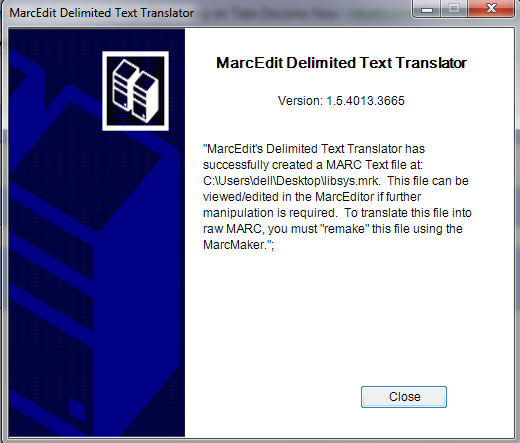
انقر فوق إغلاق وأنشأ ملف مارك. MRK من ملف الأكسل XLS. في هذه الخطوة. يمكنك عرض الملف بالنقر المزدوج عليه.
تحويل ملف. MRK إلى ملف. MRC
سوف نقوم بتحويل ملف. MRK الذي قمنا بإنشائه في الخطوة أعلاه في شكل مارك الخام الذي يمكن استيراده مباشرة في نظام كوها.
نعيد فتح برنامج محرر مارك مرةً آخرى و نختار أدوات مارك.
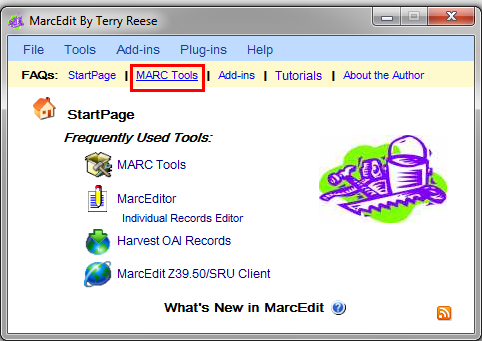
التالي إختر برنامج مارك لتحويل الملف من .mrk الى هيئة .mrc.
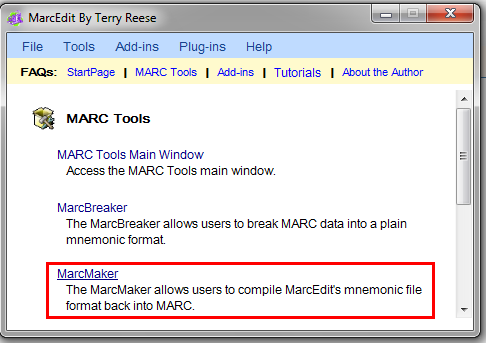
تحديد موقع ملف الإدخال واسم الملف الإخراج الخاص بك. انقر فوق تنفيذ.
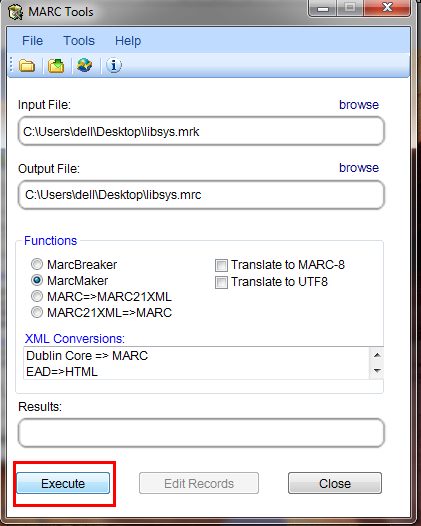
وسوف تظهر لك النتيجة.
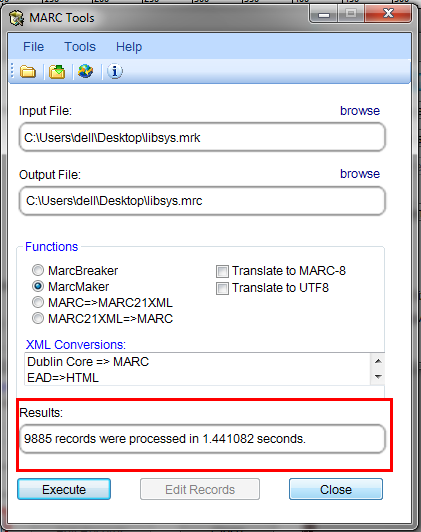
انقر فوق إغلاق والآن لدينا سجلات مارك الخام معنا (الملف.MRC ).
إستيراد ملف.MRC في نظام كوها
More information on importing records into Koha can be found in the 'Stage MARC records for import' section of this manual.
وأخيرا سوف نستورد ملف.mrc الذي تم إنشاؤه أعلاه في نظام كوها.
انقر على الأدوات في عميل الموظفين الخاص بك بنظام كوها.

بعدها إضغط على تنظيم تسجيلات مارك للإستيراد.
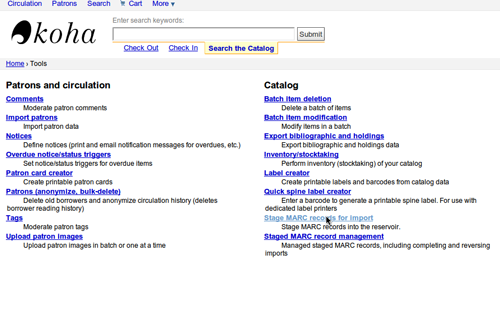
بعد ذلك، اختير ملف .mrc الذي تم إنشاؤه مسبقاً. وانقر على تحميل.
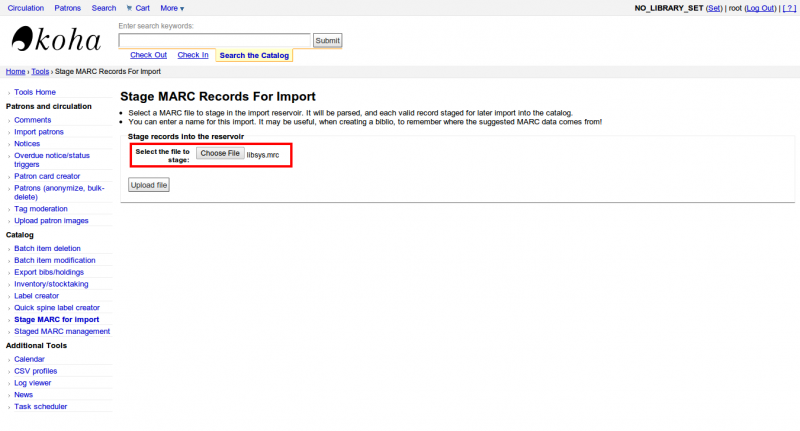
يمكنك أيضاً إضافة تعليق حول الملف وأخيرا انقر على تنظيم للإستيراد.
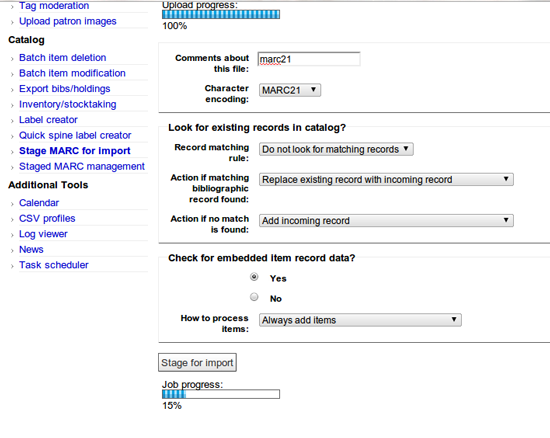
عندما يتم الإستيراد, سوف تحصل على نتيجة شيء من مثل هذا
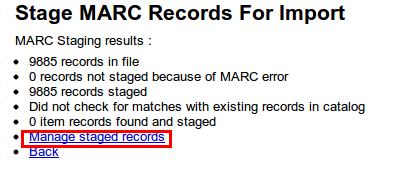
التالي، انقر على إدارة تنظيم السجلات.
هنا يمكنك تغيير حتى قواعد المطابقة.
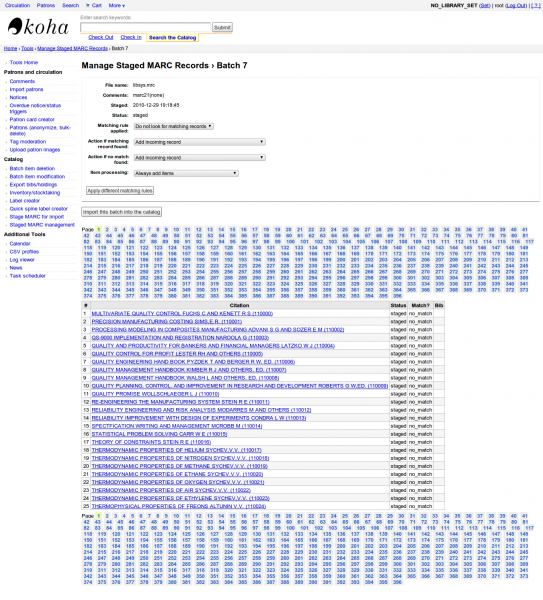
انقر على إستيراد هذه الدفعة في الفهرس عند الانتهاء.
بعد هذا. بعد الحصول على كافة السجلات المستوردة تأكد من الحالة ويجب ان تصبح "مستوردة"
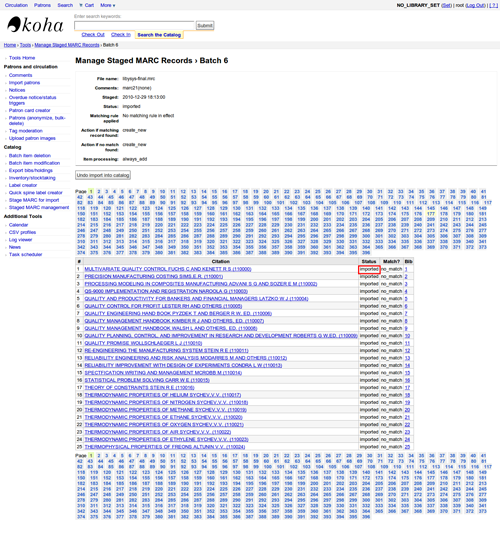
يمكنك حتى التراجع عن عملية الإستيراد.
وفي غضون دقائق قليلة، استوردنا حوالي 10،000 من السجلات في نظام كوها
OCLC Connexion Gateway
Koha can be set to work with the OCLC Connexion Gateway. This allows libraries to use OCLC Connexion as their cataloging tool and simply send those records to Koha with a single click. The following instructions will help you set up the OCLC Connexion Gateway, if you have a system administrator you will want to consult with them on this process.
Setting up OCLC service on Koha
First, you'll need to create a file somewhere on your system with configuration information. You could put this anywhere that is visible to the account that will be running the service.
The file contains 11 lines. The first 6 will be about your Koha system:
host: The IP address of your Koha server
port: The port you want to use for the Connexion service. This port must be different from your SIP port, or any other service
koha: The full URL of your staff client
log: The location (full file specification) of your log for the service
user: The default Koha username to use for importing
password: The password that goes with that username
The remaining lines describe how to do the staging:
match: The name of the matching rule from your system to use
overlay_action: "replace", "create_new", or "ignore"-- what to do if there is a match
nomatch_action: "create_new" or "ignore"-- what to do if there is no match
item_action: "always_add","add_only_for_matches","add_only_for_new", or "ignore" -- what to do with embedded 952 item data
import_mode: "direct" or "stage"
التخطيط يَبْدو مثل هذا:
host: 1.2.3.4
port: 8000
log: /home/koha/koha-dev/var/log/connexion.log
koha: http://kohastaff.myuniversity.edu
user: koha_generic_staff
password: password
match: 001
overlay_action: replace
nomatch_action: create_new
item_action: ignore
import_mode: direct
When choosing an 'import_mode' if you use "direct" then the staged record will be immediately imported into Koha, and should be searchable after your indexes catch up. If you choose "stage", then the record will be placed in a staged batch for you to later go the Manage Staged MARC Records tool to finish the import.
If you import multiple records, they'll be in the same batch, until that batch is imported, then a new batch will be created.
In "direct" mode, each record will be in its' own batch.
ثم أبدأ الحصاد:
/location/of/connexion/import/daemon/connexion_import_daemon.pl -d -c /location/of/config/file.cnf
Setting up your OCLC desktop client
Note
Screenshots are OCLC Connexion Client v.2.50, Koha v.3.12
To set up the OCLC Connexion desktop client to connect to Koha, go to Tools > Options, then choose the Export tab.
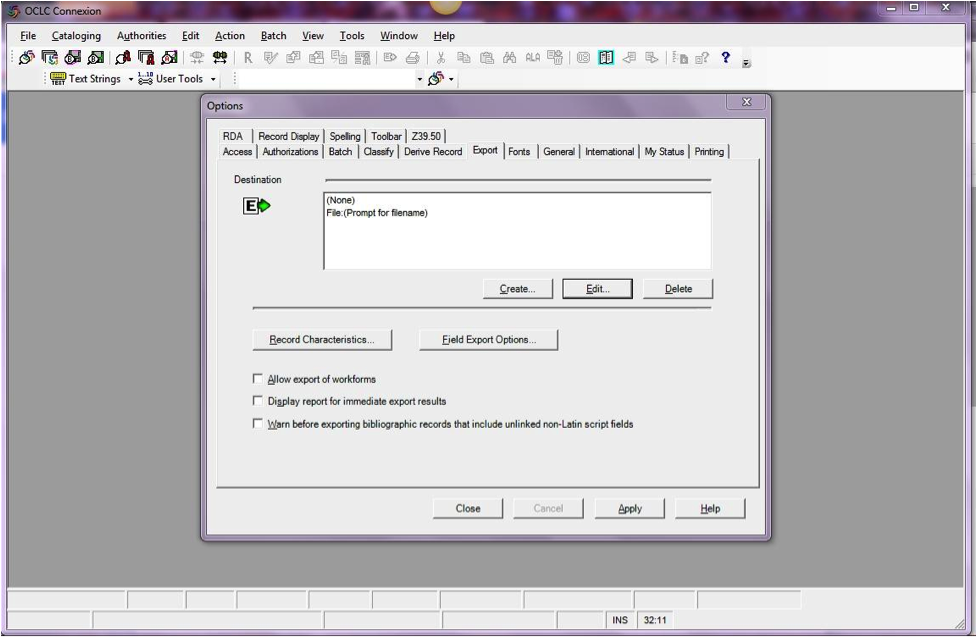
Click the "Create..." button to set up a new destination, then choose "OCLC Gateway Export" and click OK.
ومن ثم أدخل معلومات الاتصال
"Host Name:" Your catalog’s appropriate IP address (from your config file above)
"Port:" Your catalog's appropriate port number (from your config file above)
"Login ID:" The cataloger's Koha login
كلمة المرور= كلمة مرور حساب الموظفين الخاص بك
"Notify Host Before Disconnect" = checked,
"Timeout" = 100, "Retries" = 3, "Delay" = 0 (zero),
"Send Local System Logon ID Password" = checked.
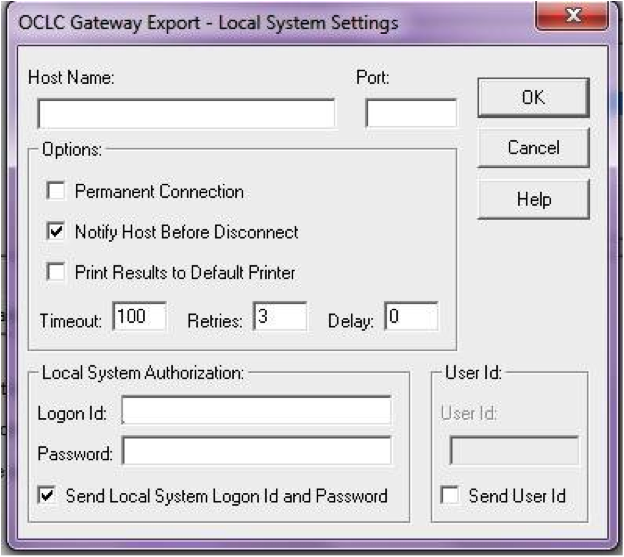
Select "OK" when finished, and you should see your new "Gateway Export" option listed (The catalog's IP address and port are blacked out in the following screenshot)
التاريخ المضاف
Click on "Record Characteristics" and make sure that the bibliographic records are using MARC21, UTF-8 Unicode, and click OK to save.
خصائص التنسيق الخاصة
You should be ready to go! To export a record from OCLC Connexion Client to Koha, just press F5 while the record is on-screen. The export dialog will pop up, and you'll see Connexion attempting to talk to Koha. You should get a message that the record was added or overlaid, including its biblio number, and a URL that you can copy into your web browser to jump straight to the record.
Using the OCLC Connexion Gateway
Records can be exported from Connexion either in a batch or one by one.
أو قم بإدراج الباركود واحدا تلو الآخر
To export bibliographic records one by one, be sure your "Batch" options are correct: from the "Tools" menu, select "Options", and select the "Batch" tab. In the "Perform local actions in batch" area, "Bibliographic Record Export" should be unchecked
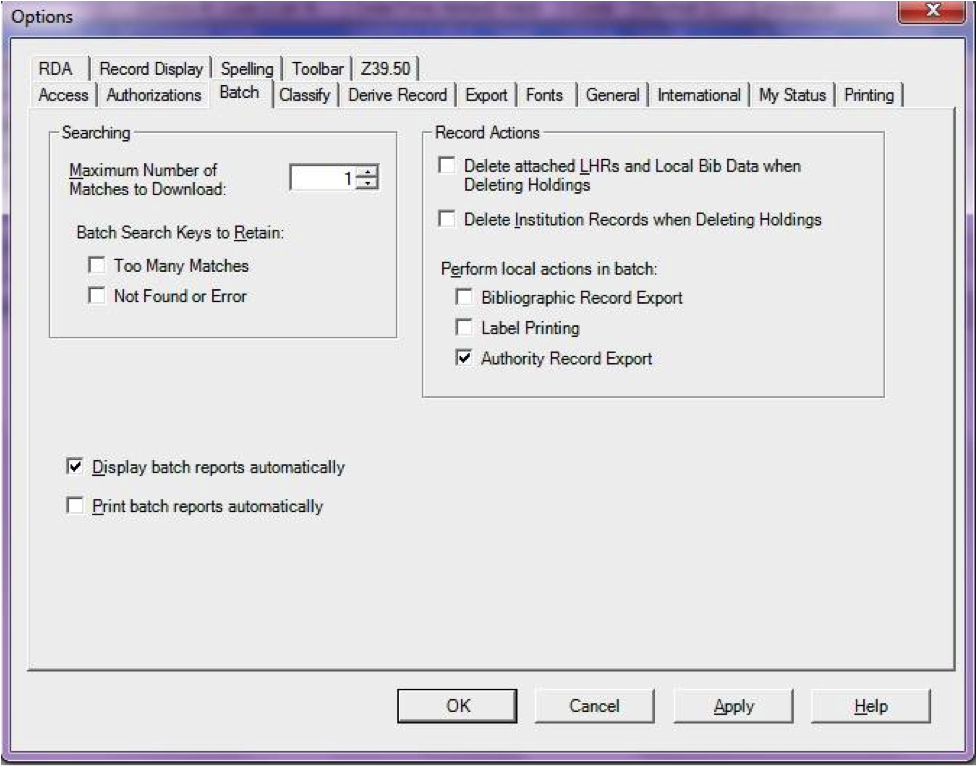
When ready to export, from the "Action" menu, select "Export" or use the F5 key. You will see a screen similar to the following if the import is successful and if the record is new to the Catalog; you may copy & paste the resulting URL into your Koha catalog to see the new record.
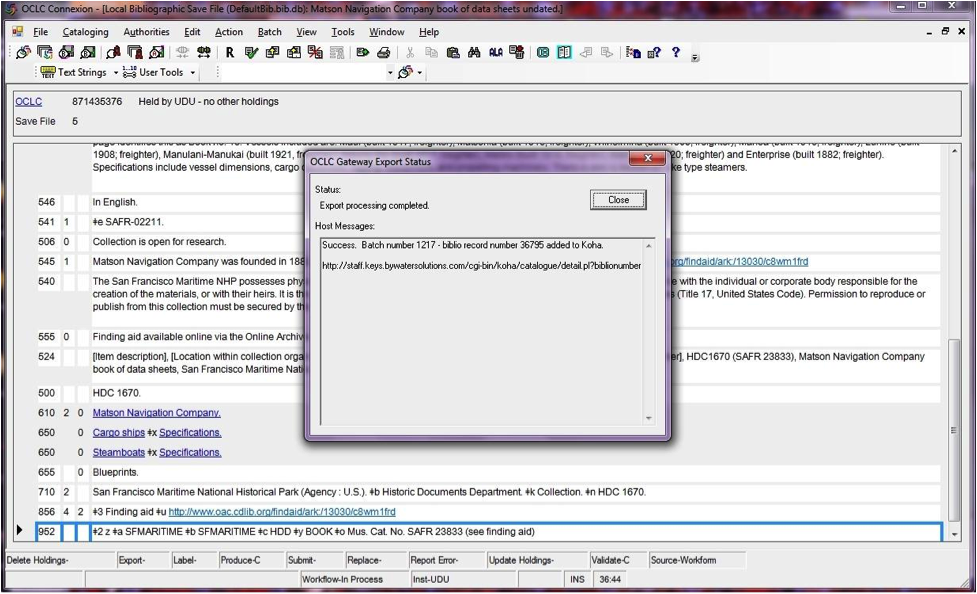
If the record was overlaid, you will see a message to that effect in the "OCLC Gateway Export Status" window

تصدير دفعة بطاقات
To export bibliographic records in a batch, be sure your "Batch" options are correct: from the "Tools" menu, select "Options", and select the "Batch" tab. In the "Perform local actions in batch" area, "Bibliographic Record Export" should be checked
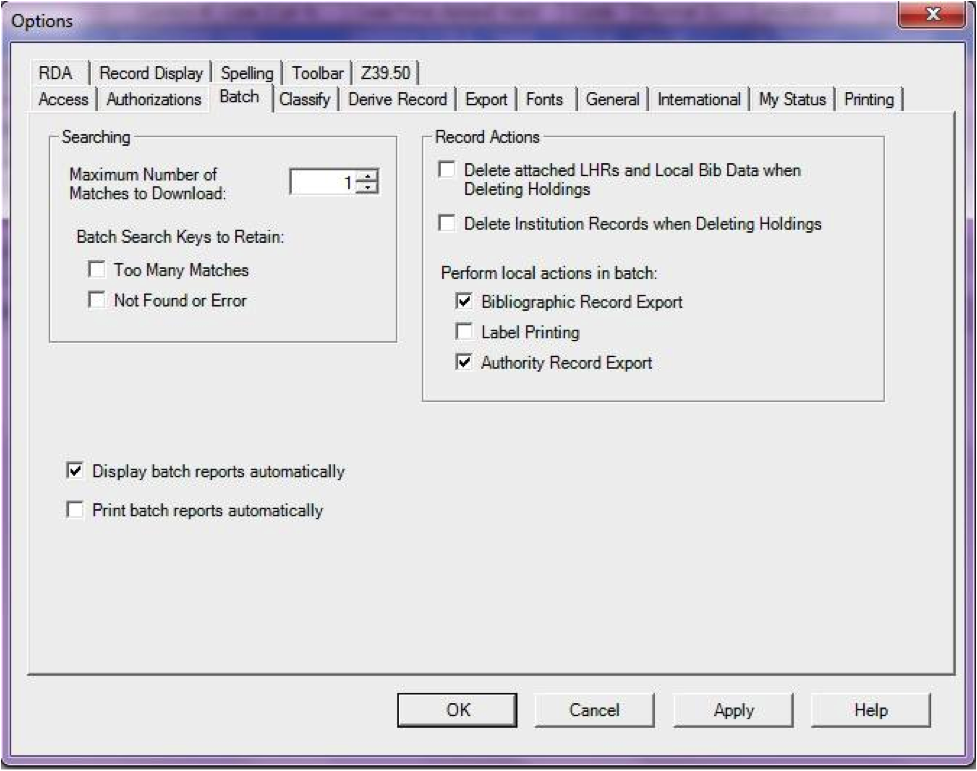
When a record is ready to export, from the "Action" menu, select "Export" or use the F5 key, and it’s export status will be "ready."
When ready to export the batch, from the "Batch" menu, select "Process batch" and check the appropriate "Path" and "Export" boxes
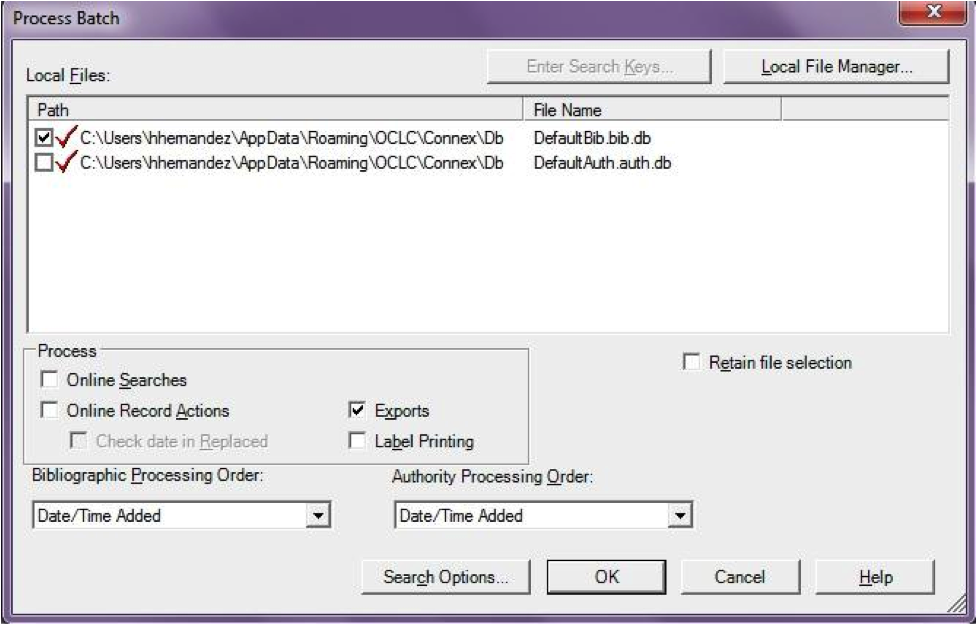
The export will begin, and the bib records will be exported & imported into Koha one by one; you will see "OCLC Gateway Export Status" windows, as above, showing you the results of each export. That window will stay there until you select "Close," and then the next record’s export/import will begin. The process will continue until all records in the batch are completed. Then you may or may not see the Connexion Client export report (depending on your Client options for that).
Items in OCLC
If you'd like to create your item records in OCLC you can do so by addding a 952 for each item to the bib record you're cataloging. The location and item information cataloging guide will break down what subfields you can use in the 952, but at the minimum you want to have subfield 2, a, b, and y on your items.
952 \\$2CLASSIFICATION$aHOMEBRANCHCODE$bHOLDINGBRANCHCODE$yITEMTYPECODE
The subfield 2 holds the classification code. This can be ddc for Dewey or lcc for Library of Congress or z for Custom. Other classification sources can be found in the Classification Sources area in administration
Subfield a is your home library and needs to be the code for your home library, not the library name. You can find these codes in the Libraries administration area.
Subfield b is your holding library and needs to be the code for your holding library, not the library name. You can find these codes in the Libraries administration area.
Subfield y is your item type code. It needs to be the code, not the item type name. You can find these codes in the Item Types administration area.
952 \\$2ddc$aMAIN$bMAIN$yBOOK
In addition to these required fields you can enter any other subfield you'd like. Most libraries will enter a call number in subfield o and a barcode in subfield p as well. Review the Location and item information cataloging guide for a full list of subfields and values.
تقنية التحدث الى
Talking Tech I-tiva is a third party, proprietary, product that libraries can subscribe to. Learn more here: http://www.talkingtech.com/solutions/library.
التنصيب وتعليمات التثبيت
تأكد من أنك قمت بتنفيذinstaller/data/mysql/atomicupdate/Bug-4246-Talking-Tech-itiva-phone-notifications.pl لتنصيب حزمة البيانات المطلوبة (جديد syspref, إشعارات المواد النائبة ورسائل نقل التفضيلات)
To use, TalkingTechItivaPhoneNotification syspref must be turned on.
If you wish to process PREOVERDUE or RESERVES messages, you'll need the EnhancedMessagingPreferences system preference turned on, and patrons to have filled in a preference for receiving these notices by phone.
For OVERDUE messages, overdue notice triggers must be configured under More > Tools > Overdue notice/status triggers. Either branch-specific triggers or the default level triggers may be used (script will select whichever is appropriate).
إرسال إشعارات الملف
Add the TalkingTech_itiva_outbound.pl script to your crontab
إضافة FTP / SFTP أو غيرها من طريق النقل لإرسال ملف الإخراج إلى مخدم I-TIVA
إذا كنت ترغب في ذلك،إشعارات أرشفة الملفات ترسل في دليل آخر بعد الإرسال
Run TalkingTech_itiva_outbound.pl --help for more information
إستِلام ملفِ النَتائِجِ
إضافة FTP / SFTP أو غيرها من طريق النقل لإرسال الملف النتائج إلى دليلك المعروف على مخدم نظام كوها
Add the TalkingTech_itiva_inbound.pl script to your crontab, aimed at that directory
إذا كنت ترغب في ذلك، ملف نتائج الأرشيف في دليل آخر بعد المعالجة
Run TalkingTech_itiva_inbound.pl --help for more information